Don’t believe it? Page through David P. Morgan’s seminal work Steam’s Finest Hour (Kalmbach, 1959) where Morgan states in the 1950s Yellowstone’s were pulling ore trains of more than 19,000 gross tons with tractive effort of 140,000 pounds. Big Boy’s tractive effort is listed as 135,375 pounds. But neither machine could match the all-time champ for a simple articulated: Great Northern’s R-2 Class 2-8-8-2s generated 146,000 pounds of tractive effort. Unfortunately, there are no R-2s extant today.
As part of the Big Boy’s visit to Duluth, the museum put together a comparison of the two locomotives:
Why were such locomotives needed in Minnesota, which most people consider as flat and gradeless? The answer comes from geography and the Missabe’s main commodity: iron ore. “Natural” ore (versus taconite pellets moved today) is heavy: it’s like moving carloads of dirt. The DM&IR, created in 1938 with the merging of the Duluth, Missabe & Northern and Duluth & Iron Range, was facing increases in iron ore traffic and had to contend with “up and down” grades on the former D&IR. According to Frank A. King’s book “Locomotives of the Duluth, Missabe & Iron Range” (Pacific Fast Mail, 1984) between Biwabik and Two Harbors maximum ruling grades for loaded trains were 0.62 percent at three locations varying from one to three miles. DM&IR looked to Baldwin for engines capable of handling 115-car, 8750-ton trains over the grades without stalling.
The result were eight 2-8-8-4s built by Baldwin Locomotive Works for the Missabe in 1941, partially based on Baldwin’s Western Pacific 2-8-8-2s built in 1931 and 1938. Their name came from the Northern Pacific, which owned the first of the type and named them for its Yellowstone Division. They weighed some 566 tons, were 128 feet in length, and their initial cost was $246,570 each. They were assigned to Two Harbors and used to move ore trains from the mines of the Vermilion and Mesabi Ranges. The engines far exceeded expectations, developing 6,000 horsepower and hauling 180-190 ore car trains. They consumed 10 to 12 tons of coal an hour and under load evaporated water into steam at a rate of 12,000 gallons per hour. An additional ten Yellowstone’s were delivered in 1943.
The Yellowstone’s even outlasted the Big Boys: the last ore run pulled by a 2-8-8-4 was made on July 5, 1960, nearly a year after the final Big Boy operation. Two Yellowstone’s operated on separate excursion trains out of Duluth on July 2, 1961, the last operations of the giant engines, although recently unearthed photos in the Museum collection provide evidence that Yellowstone No. 229 was under steam at the roundhouse in Proctor as late as November 1961.
During its 20-year operating life No. 227 hauled approximately 40 million long tons of iron ore (a “long ton” is approximately 2,240 pounds). It pulled its last ore train in June 1960, then was set aside for preservation, thanks to the efforts of DM&IR Vice President and General Manager Donald B. Shank. He had it placed inside the roundhouse in Proctor with the word “Save“ chalked on it. When the Museum project began in the early 1970s, No. 227 was earmarked to become the centerpiece exhibit. With the assistance of the DM&IR Veteran Employees Association, whose members raised over $8,000 for the project, it was restored and moved to the Depot in 1974.
In 2017 Union Pacific Senior Manager for Heritage Operations Ed Dicken’s came to Duluth to speak about the Big Boy restoration. While there, he asked to inspect No. 227, crawling around the engine. The museum even opened up the smokebox so he could take a look inside. Dicken’s declared the engine was in better shape that the 4014 – which could be expected since No. 227 was never stored or displayed outdoors. No. 4014’s journey to Duluth is no doubt a result of Dickens earlier trip to the Museum.
So, from July 19-21, it will be possible to inspect these two steam giants at once: one alive and under steam, and the other as close as you can get without actually being steamed. This is thanks to the unique way No. 227 is displayed, with revolving wheels and recorded sound. Its driving wheels are slightly suspended above the rails. Two electric motors are geared to a sprocket mounted in the axles that turn the wheels, allowing visitors to view No. 227’s massive machinery in motion. Every 30 minutes the locomotive comes to life, with an electronic system setting in motion the drivers, turning on the engine’s lights, and activating recorded sounds of 227 pulling ore trains in 1959. An accompanying narrative highlights the engine’s history and features. Visitors are also welcome to walk into the cab of the 227 and peer into its massive firebox.
If only these two locomotives “born” in 1941 could talk, what stories they could tell!





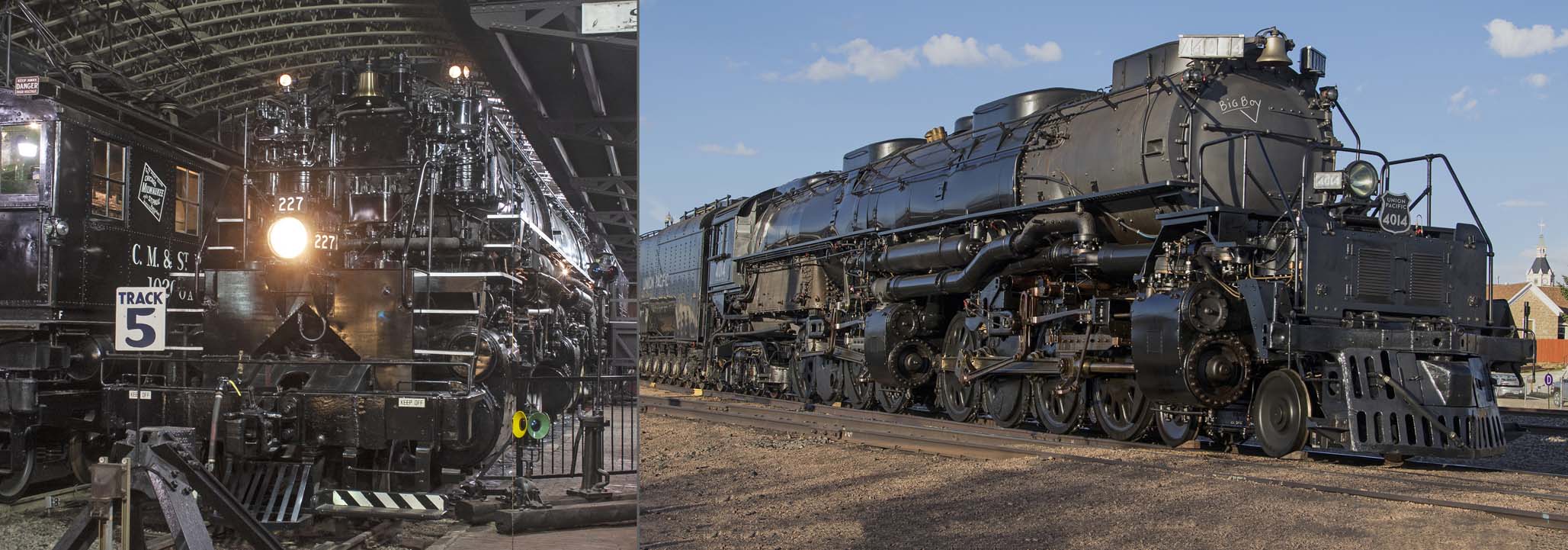
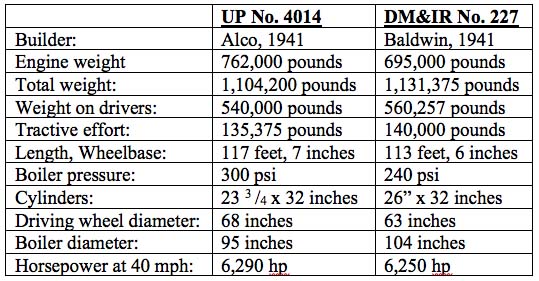


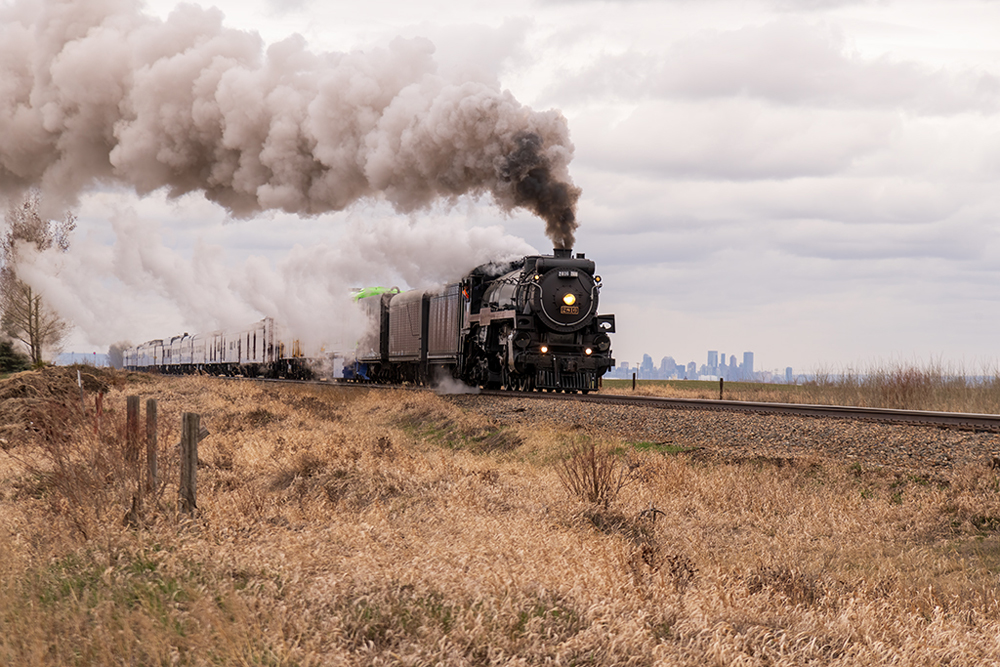
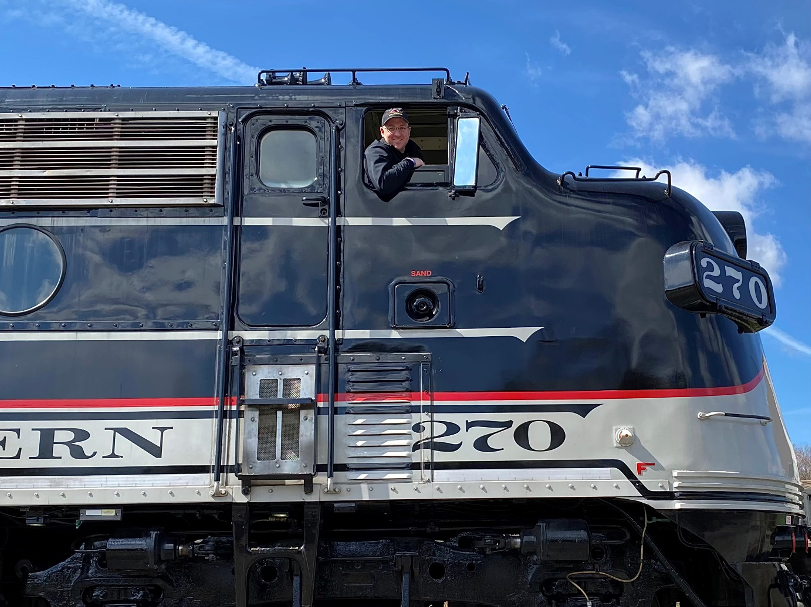
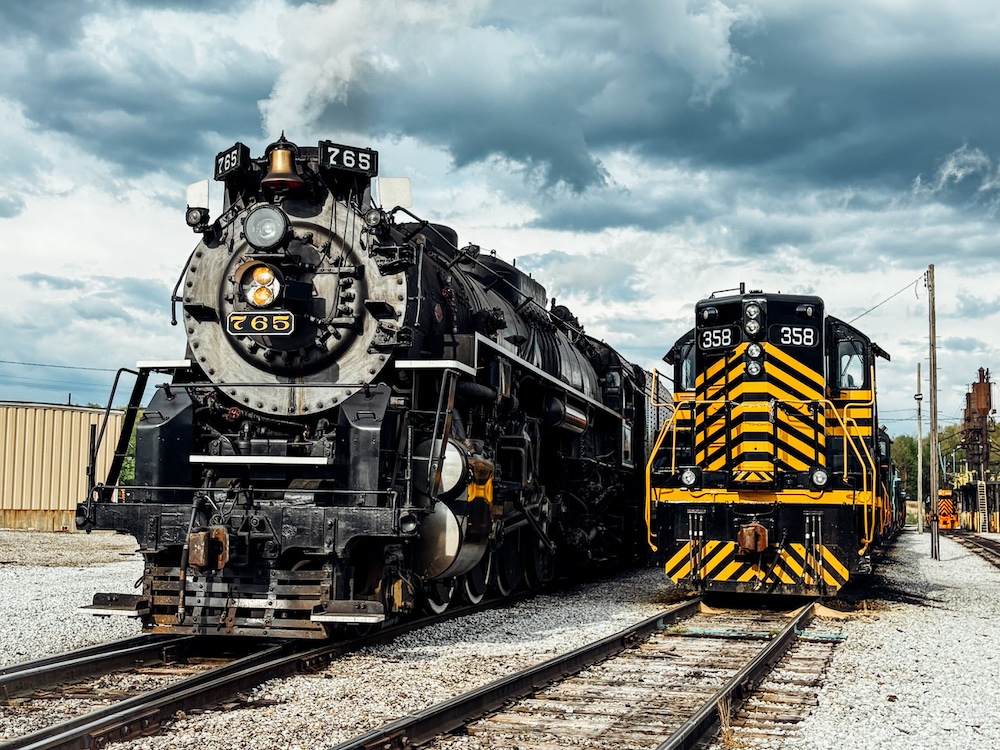




The Challengers ,Cab Forwards, and 2-6-6-4 are left out,I don’t know why
The Yellowstone is actually named after the national park the NP mainline runs by
As a follow-up to my previous comment, I just found a comparison table in one of my steam engine books.
GN R-2, 2-8-8-2, drivers = 63″, boiler horsepower = 6,820, tractive effort = 142,060 lbs (after modifications).
WP M-137-151 2-8-8-2, drivers = 63″, boiler horsepower = 6,590, tractive effort = 137,000 lbs
DM&IR M-3 2-8-8-4, drivers = 63″, boiler horsepower = 7,140, tractive effort = 140,000 lbs
UP 4000 4-8-8-4, drivers = 68″, boiler horsepower = 6,520, tractive effort = 135,375 lbs
C&O H-8 2-6-6-6, drivers = 67″, boiler horsepower = 7,330, tractive effort = 110,200 lbs
All the above tractive effort figures do not include boosters if so equipped.
So even in horsepower, the Big Boy was smallest of the above engines, and 2nd smallest in tractive effort.
The Big Boy had a lot of “big publicity” about it. Other railroads had steam locos with more pulling power as cited above. Another two that I know of were the Great Northern’s 2-8-8-2 classes R-1 and R-2. Baldwin built four of the R-1 and the GN built ten R-1 and sixteen R-2 in their own shops at Hillyard, WA (just outside of Spokane). The R-1 class, built 1925 to 1928, was rated 136,600 lbs tractive effort, beating the Big Boy but not the DM&RI 227. But the R-2 class, built 1929 to 1930 beat them both with 146,000 lbs tractive effort when built. They later made some modifications to the class R-2 locos that brought them down to “only” 142,060 lbs tractive effort, still beating both the Big Boy and the DM&IR 227. And this was a good decade or so before the Big Boy or the DM&IR 227 were built. I’ll have to admit that the R-1 and R-2 class were NOT built for speed, but for power to get over the mountains with long freight trains. I believe I heard or read somewhere that over about 35 mph, they really pounded the rails. Like the DM&IR 227, they had 63″ drivers for good pulling power where the Big Boy’s 68″ drivers gave it a bit more speed while still providing a LOT of pulling power. But the GN, and I imagine the DM&IR, weren’t full of hot air like the UP, so at least for the GN, the R-1 and R-2 class locos plugged away without any publicity.
I am wondering if the Missabe Yellowstone’s specs are the same as the Northern Pacific Yellowstone’s?
George Pin, there are several advantages of higher steam pressure (i.e. 300 psi vs 240 psi). First, higher steam pressures are more thermodynamically efficient, meaning a locomotive operating at 300 psi can produce more work from a given amount of energy input than a locomotive operating at 240 psi. Second, the smaller cylinder bores made possible by higher steam pressure translate to smaller, lighter pistons that are easier to balance and can operate at higher speeds than the heavier pistons required when operating at significantly lower pressures. If you think about the most modern, state of the art steam locomotives developed in the United States in the 1940s, almost all were operating at 300 psi. The list includes the Norfolk & Western A, J, and Y6, Santa Fe’s last Northerns and 2-10-4’s, UP’s Big Boys and FEF Northerns, and Pennsy’s T1 and Q2 duplexes.
Great article. Keep up the fine work.
Thanks for the very interesting piece about 4014 going to Duluth, but why the apostrophized “Yellowstone’s?” A group of them is simply a group of Yellowstones. No possessive required. Yes, I’m a nitpicker, but…
Stephen Roberts – Ok, I understand your calculation. but there must be a big negative to increasing cylinder diameter to increase tractive effort, else why run at 300psi at all, vs. less mechanical strain, design strength, etc. needed to run at 240 and achieve the same tractive effort?
George, not an expert on anything but what a great question. Hoper someone can articulate an answer as would love to learn as well
The title of this article is somewhat misleading. I think you meant to say the meeting will be NEXT month not THIS month
George Pins, one interesting reason in why DM&IR’s pressure was set to 240 psi, but could put down higher tractive effort than the Big Boys was due to having pistons 2 inches larger in diameter. Although they both had 63” drivers and same stroke lengths of 32”, due to the way that steam tractive effort is figured, a 2” difference in cylinder bore can mean a great difference even with less pressure when you run the numbers.
The formula: t=(0.85d^2nsp)/2w
t=tractive effort
d= piston diameter (bore) in inches
n= number of cylinders
s= stroke in inches
p= boiler pressure in pounds per square inch
w= wheel diameter in inches
0.85 AAR constant value for rolling resistance (Does not distinguish differences between friction and roller
bearings, nor valve timing)
Actually the Yellowstone locomotive is named after the national park where NP line runs by
James the Big Boy will be in Duluth JULY 20
Comparing an A class to a Big Boy or a Yellowstone is more of the “apples and oranges” than the comparison of the Y-class. The A had 12 drivers, the other 3 engines 16. And Steve Bauer, I agree 100% I’ll take that Y-class any day over a Big Boy, a tonnage contest with a Yellowstone would be an impressive sight, especially if it could be done side-by-side. And not to insult the A-class, those were impressive engines as well. Those guys in Roanoke had it going on, best steam shop in America.
Comparing a N&W Y6 to a UP Big Boy or DM&IR Yellowstone is a bit like comparing apples and oranges. First, all classes of the Y’s were Mallet (i.e. compound) articulateds, while the Big Boys and Yellowstones were simple articulateds. The Y’s had smaller drivers and were designed for slow drag service, while the Big Boys and Yellowstones had their highest output at faster speeds. From what I could find, the best the Y’s could produce was about 5600 hp at 25 mph, while according to the table with this article the Big Boys and Yellowstones could produce 6290 and 6250 hp at 40 mph. Granted the Y’s won at tractive effort; I found the best Y’s could generate 166,000 lbf, while (again according to the table above) the Big boys and Yellowstones could only do 135,375 and 140,000 lbf.
Perhaps a more appropriate comparison would be with a N&W A (2-6-6-4) which was a simple articulated, like the Big Boys and Yellowstones. (I haven’t looked up what an A could do.)
But if a N&W Y6b is what turns you on, who am I to criticize your personal taste.
that is cool article, never knew about the DM&IR engine, familiar with the RR name but never knew they needed such pulling power. will be great for those in attendance to see the two of them together.
Meet its match? Is there going to be a tonnage pulling contest up Proctor hill or something?
Keep the 4014. I’ll take an N&W Y6B.
Boy those facts have break some UP hearts.
Too bad 227 isn’t operable. It would make for an exciting tug-of-war between 227 & 4014.
Could one of our experts please tell me why 227’s boiler pressure is 240, compared to 300 for 4014 and, I believe, about 300 for most modern steam locos? Seems low, but I’m sure there’s a reason that makes sense.